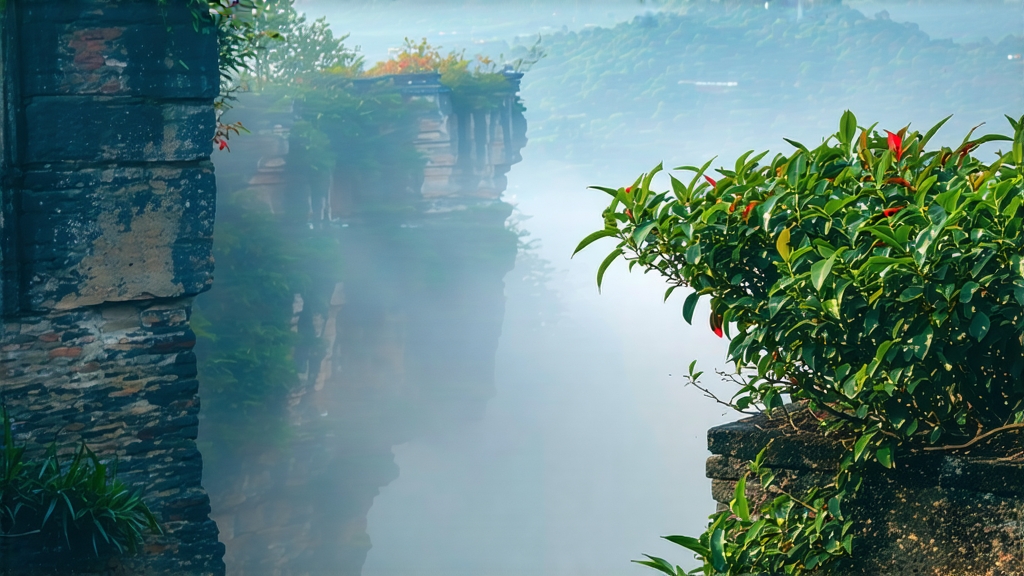
Among the six great tea families of China, oolong alone occupies the aromatic midpoint between green freshness and black depth. Within this semi-oxidised realm, no name carries more myth, more mineral magnetism, than Da Hong Pao—Big Red Robe—born on the vertiginous cliffs of northern Fujian’s Wuyi Mountains. To international drinkers who know oolong only as a floral Taiwanese pouchong or a creamy “milk” Tie Guan Yin, Da Hong Pao offers a darker, more primordial profile: the taste of granite, pine smoke and long-forgotten dynasties.
-
Legends carved in stone
The most quoted origin tale dates to the Ming dynasty. A passing scholar, en route to the imperial capital, fell ill on the Wuyi trails. Monks from the Tianxin Temple brewed leaves picked from four stunted bushes clinging to a rocky cleft; the traveler revived, passed the top-tier exams and returned in gratitude, draping his own crimson robe over the shrubs to protect them from winter frost. Whether parable or fact, the story fixed the name and the colour red—auspicious in Chinese culture—into tea lore. In 2006 the original “mother” bushes, estimated at over 350 years old, were retired from plucking by government decree; the last 20 g of their leaf, auctioned in 2005, fetched roughly US $30,000, sealing Da Hong Pao’s status as liquid antiquity. -
Terroir: when rock becomes flavour
Wuyi’s Danxia landforms—purple-red sandstone and tuff weathered into knife-edge ridges—create a natural amphitheatre that traps cloud and mist. Day-night temperature swings of 15 °C slow leaf growth, condensing amino acids and volatile aromatics. Thin, mineral-rich soils force roots to probe fissures for water, absorbing calcium, potassium and magnesium that later translate into the celebrated “yan yun” (rock rhyme), a tactile finish reminiscent of wet slate and river stone. Four micro-climatic gullies—Nine-Dragon Gorge, Huiyuan Rock, Tiger Roar Rock and Matou Cliff—produce the most coveted “Zheng Yan” (true cliff) leaf, while surrounding tablelands supply “Ban Yan” (half cliff) and still farther plains give “Zhou Cha” (river tea), each step outward loosening the mineral grip on the cup. -
Varietal bloodlines
Da Hong Pao is simultaneously a proprietary brand and a genetic family. The original “Qi Dan” cuttings, taken from the mother bushes before the plucking ban, are now cultivated in limited pockets inside the scenic reserve. Because pure Qi Dan is scarce, the market recognises two other legitimate expressions:- Beidou #1 & Beidou #2—clonal lines selected in the 1980s from the mother plants via tissue culture, maintaining about 92 % genetic similarity.
- Commercial blends—skillful marriages of three or four Wuyi cultivars (often Rou Gui for spice, Shui Xian for orchid depth, and Tie Luo Han for structure) that aim to echo the mother bush profile. Purists debate the ethics of blending, yet the practice dates back to Qing-era tea merchants who needed to stretch precious leaf for Persian and Russian caravans.
-
Craft: the nine-step odyssey
Pluck: only the middle three leaves are taken in late April, when the leaf’s edge shows a faint bronze rim—nature’s first hint of oxidation.
Wither: trays set 2 m above smouldering pine charcoal racks for 2–3 h; infrared thermometers keep the leaf surface below 34 °C to avoid “cooking”.
Shake: perhaps the most cinematic stage, the leaves are tumbled in 1.2 m diameter bamboo drums rotating at 18 rpm for 5 min, rested, then shaken again—up to seven cycles—bruising epidermal cells so that enzymes meet oxygen.
Oxidise: the leaf is left in waist-high piles on hemp cloth for 2–4 h, turned every 20 min; masters sniff palms to decide when green grassiness yields to peach skin and copper penny.
Kill-green: a 260 °C wok flash-fries the leaf for 7 min, halting oxidation at roughly 45 %—the midpoint that gifts oolong its bi-coloured liquor.
Roll: machine-pressed into tight twists reminiscent of black-dragon eyebrows, breaking